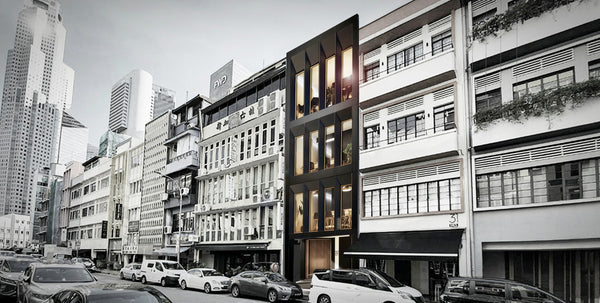Wine Collection Starter Kit
Are you thinking of starting a new hobby of collecting wines? Not sure where and how to start? Fret not! We would love to help. Read our guide to find out what you need!
Wine Fridge
Of course, the most important must-have must be said first.
Why can’t we store wines in our regular refrigerators? You might find storing wines in a wine fridge unnecessary but did you know that different types of wine are best stored and served at different temperatures?
When stored well, you will be able to achieve the best taste and aroma that the wine offers. Regular fridge doesn’t offer a wide range of temperature controls compared to a wine fridge and may leave your wines too cool or too warm, hence affecting its taste. See here for the recommended temperatures for different wines.
One will also less likely open wine fridges as much as the normal refrigerator. This will reduce the impact of environmental changes on the wines. Refrigerators are also designed to reduce humidity while wine fridges are designed to maintain humidity level. If stored in undesired humidity levels, wine corks will start to shrink and absorb unwanted odours. Imagine getting a whiff of durian that was stored in your fridge while sipping your Merlot!
Storing wine in a room or kitchen is definitely not ideal for preserving your wines. The impact of the environmental changes will be way too much, especially so in Singapore’s climate! And, getting a wine fridge just for your wines, also means more space! No more sharing with other food and drinks in the refrigerator. Your wines deserve a proper home.
Consider the following factors when choosing a wine fridge:
-
Cooling method: Compressor or Thermoelectric? - In terms of cooling, compressors cool better and typically offer a larger temperature control range. Thermoelectric cooling depends very much on ambient temperature and in Singapore’s climate, most thermoelectric models can only go to about 14-18°C, suitable only for storing reds. Thermoelectrics, however, have no harmful substances or emissions and hence are environmentally friendly products as compared to compressors. Thermoelectrics also operate quietly with no vibration.
-
Number of zones: (Single/Dual/Triple) - the choice between single-zone or dual-zone fridge all comes down to what type of wines you intend to store. The single-zone is meant for storage of one type of wine or different types of wines that can be stored in the same temperature since this configuration only offered a single temperature control throughout the fridge. On the other hand, the dual or triple zone is equipped with two or three separate spaces respectively with independent control of temperature, making it easier to serve different types of wines at their optimal serving temperatures.
-
Placement of Fridge: (Freestanding or Built in)- You will find built in or undercounter models with heat vents in front versus at the back for freestanding models. You can’t place freestanding models under the counter or built in as this not only spoils your cabinets, it also prevents the fridge from cooling effectively due to lack of air ventilation. Also, consider whether the space allows for the smooth opening of the door and easy retrieval of wines. If needed, some models do offer a change of door hinge, but do note to inform prior to delivery!
-
Design: (Stainless or Black finish?)- Of course, consider the space where you are placing the fridge. Does it fit well into the design? Most wine fridges come in either black or stainless steel finish. But if you would like something special and you are able to wait for something good, consider the white finish from Kadeka here.
-
Shelvings: (Number & material of shelvings)- When buying a wine fridge, most are concerned about the number and material of shelves. Having more shelves will reduce the space you will have to stack. So do consider the size of bottles and design construction of the shelves before you buy. If you are looking to store odd sized champagnes or bigger bottles, do consider a bigger sized fridge or you may be unable to fit them due to spacing design between shelves. You may also have to remove a shelf in order to create more space to fit. Do also consider if you need adjustable or telescopic shelves. Meanwhile, the materials of the shelf are all about durability and aesthetics. Shelves could be made of wood, metal and wood-metal hybrid. Wooden shelves are mostly used for sturdiness. Some are combined with metal capped ends that not only increase the aesthetic points, but also provide extra support for the bottles.
-
Capacity- Wine fridges capacity are advertised based on standard bordeaux sizes. Because bottles vary in shapes and sizes, realistically most wine fridges will only hold 80% of advertised capacity. It is best to choose a fridge with a capacity twice as much as your current collection, to account space for future expansion of collection.
-
Extra features- Some wine fridges also offer features such as locks, open door alarm and heated door. Do consider if you need any!
-
Warranty- Different brands also offer different periods of warranty and some do offer extended warranty too. Some brands also offer longer warranty on compressors as compared to their services and parts. So do take into consideration the warranty too!
Check out wine fridges here! Don’t hesitate to contact us here for a recommendation if you ever need it!
Accessories
There are so many different wine accessories out there to choose from! All serve a different purpose but have the common goal of enhancing our wine drinking experience. Let us introduce them to you!
Wine Glasses
Many customers ask us if it is really necessary to drink wine from a proper wine glass? Why can’t we drink it from our favourite everyday mug?! You can, of course. But have you tried drinking from a proper wine glass? Wine glasses play a vital role in terms of collecting and releasing aromas of the wine. Try it out and we bet you can’t agree more and will not go back to using a mug!

Credits: Wine Folly
There is a scientific reason why wine glasses come in so many different shapes and sizes and why one is more suitable for a certain type of wine over another. Different glass shapes and sizes affect how much aromatic compounds get carried into your nose, whether the wine temperature should be maintained in turn affecting the taste. All this connects to form a better wine drinking experience. Don't let the wrong glass waste the bottle any further!

Credits: Decor Monk
Now, the million dollar question. Which wine glass to choose? Don’t be intimidated by the number of wine glasses to choose from! Generally speaking, fuller bodied and higher alcohol red wines like Cabernet Sauvignon have glasses with larger bowls and openings. This allows the ethanol to dissipate before reaching your nose, or you would feel the burn of the alcohol. The larger size also accounts for space to swirl your wine, letting it breathe. Lighter white wines with more fruit flavor on the other hand usually have smaller bowls and openings to preserve the fruit and floral aromas. It keeps the wine closer to your nose, and exposes less surface area of the wine to air, which will also keep it cooler.
Shop wine glasses here!
Decanter

Credits: Riedel
Featuring Riedel Cornetto Confetti Decanter
Decanters vary in shapes, colors and designs. Traditionally, they are made of glass or crystal, giving it an aesthetic and elegant appearance. But why do we need to decant wines?
Two reasons. One, decanting the wine increases oxygen exposure, softening the taste of astringent tannins (the bitterness or complex sensation of wine which was described as the dry and puckery feeling in the mouth) and allows flavours and aromas to develop. Two, decanting helps to separate wine from potential sediments. This is especially so for red wines especially the more mature ones and vintage ports. Sediment is not harmful, but affects the taste badly.
Nearly all wines can be decanted. However, younger and stronger red wines absolutely need to be decanted to smooth out the intense tannins.
To decant mature wines, let the bottle stand upright for a bit for sediment to settle to the bottom before slowly pouring it into the decanter. Stop when sediment is spotted near the opening. For younger wines, turn the bottle upside down and simply pour quickly into the decanter to burn off as much carbon dioxide as possible. Generally speaking, the older the wine, the less time it needs to be left out in the open. It is recommended to decant them 30 minutes to an hour before serving. Younger wines will benefit from decanting at least a few hours prior to consumption. Try to avoid over-decanting or the character of the wine may be burned off.
Shop Decanters here!
Coravin

Do you enjoy drinking wine alone or perhaps your drinking buddy has a different preference of wine from you? Do you always find yourself with a half opened bottle and only to return days later to find the taste not as good as the first? We have what you need- a Coravin!
The Coravin Wine Preservation System is designed to pour wine without removing the cork, so wine always tastes like it has just been opened—even years later. Now, you get to choose a different bottle everyday without wasting a single drip!
The non-coring coravin needle gently passes through corks without displacing cork material. Once the needle is removed, the cork simply expands back to its normal shape. As wine is extracted through the needle, it is replaced with pure Argon gas, ensuring oxygen never touches the remaining wine, keeping it as fresh as the day it was bottled.
Shop Coravin here!
And of course, last but not least, how can we not mention the most important thing? The wine! Grab some here!
